最优化-最小二乘法拟合
最小二乘法拟合
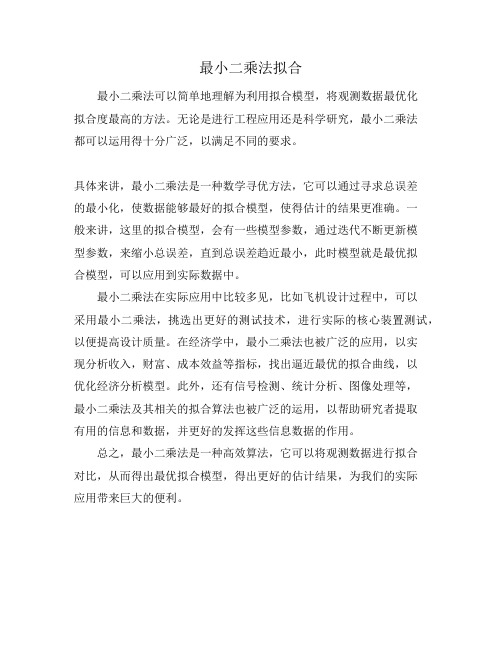
最小二乘法拟合
最小二乘法可以简单地理解为利用拟合模型,将观测数据最优化
拟合度最高的方法。
无论是进行工程应用还是科学研究,最小二乘法
都可以运用得十分广泛,以满足不同的要求。
具体来讲,最小二乘法是一种数学寻优方法,它可以通过寻求总误差
的最小化,使数据能够最好的拟合模型,使得估计的结果更准确。
一
般来讲,这里的拟合模型,会有一些模型参数,通过迭代不断更新模
型参数,来缩小总误差,直到总误差趋近最小,此时模型就是最优拟
合模型,可以应用到实际数据中。
最小二乘法在实际应用中比较多见,比如飞机设计过程中,可以
采用最小二乘法,挑选出更好的测试技术,进行实际的核心装置测试,以便提高设计质量。
在经济学中,最小二乘法也被广泛的应用,以实
现分析收入,财富、成本效益等指标,找出逼近最优的拟合曲线,以
优化经济分析模型。
此外,还有信号检测、统计分析、图像处理等,
最小二乘法及其相关的拟合算法也被广泛的运用,以帮助研究者提取
有用的信息和数据,并更好的发挥这些信息数据的作用。
总之,最小二乘法是一种高效算法,它可以将观测数据进行拟合
对比,从而得出最优拟合模型,得出更好的估计结果,为我们的实际
应用带来巨大的便利。
最小二乘法知识
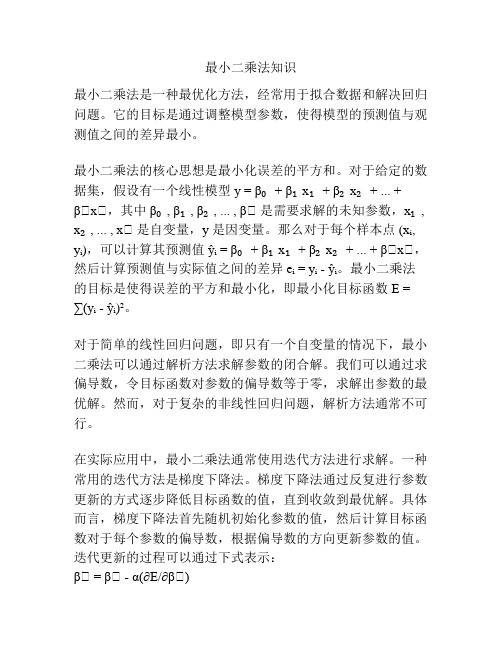
最小二乘法知识最小二乘法是一种最优化方法,经常用于拟合数据和解决回归问题。
它的目标是通过调整模型参数,使得模型的预测值与观测值之间的差异最小。
最小二乘法的核心思想是最小化误差的平方和。
对于给定的数据集,假设有一个线性模型y = β₀ + β₁x₁ + β₂x₂ + ... +βₙxₙ,其中β₀, β₁, β₂, ... , βₙ 是需要求解的未知参数,x₁, x₂, ... , xₙ 是自变量,y 是因变量。
那么对于每个样本点 (xᵢ, yᵢ),可以计算其预测值ŷᵢ = β₀ + β₁x₁ + β₂x₂ + ... + βₙxₙ,然后计算预测值与实际值之间的差异 eᵢ = yᵢ - ŷᵢ。
最小二乘法的目标是使得误差的平方和最小化,即最小化目标函数 E = ∑(yᵢ - ŷᵢ)²。
对于简单的线性回归问题,即只有一个自变量的情况下,最小二乘法可以通过解析方法求解参数的闭合解。
我们可以通过求偏导数,令目标函数对参数的偏导数等于零,求解出参数的最优解。
然而,对于复杂的非线性回归问题,解析方法通常不可行。
在实际应用中,最小二乘法通常使用迭代方法进行求解。
一种常用的迭代方法是梯度下降法。
梯度下降法通过反复进行参数更新的方式逐步降低目标函数的值,直到收敛到最优解。
具体而言,梯度下降法首先随机初始化参数的值,然后计算目标函数对于每个参数的偏导数,根据偏导数的方向更新参数的值。
迭代更新的过程可以通过下式表示:βₙ = βₙ - α(∂E/∂βₙ)其中,α 是学习率参数,控制每次更新参数的步长。
学习率需要适当选择,过小会导致收敛过慢,过大会导致震荡甚至不收敛。
最小二乘法除了可以用于线性回归问题,还可以用于其他类型的回归问题,比如多项式回归。
在多项式回归中,我们可以通过增加高次项来拟合非线性关系。
同样地,最小二乘法可以通过调整多项式的系数来使得拟合曲线与实际数据更加接近。
除了回归问题,最小二乘法还可以应用于其他领域,比如数据压缩、信号处理和统计建模等。
最小二乘优化算法
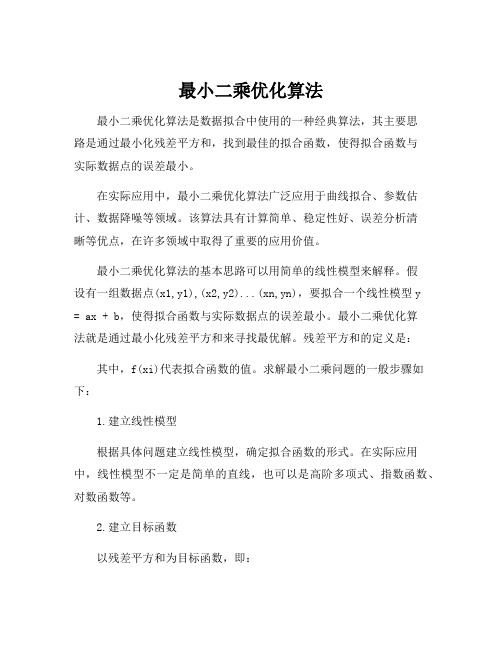
最小二乘优化算法最小二乘优化算法是数据拟合中使用的一种经典算法,其主要思路是通过最小化残差平方和,找到最佳的拟合函数,使得拟合函数与实际数据点的误差最小。
在实际应用中,最小二乘优化算法广泛应用于曲线拟合、参数估计、数据降噪等领域。
该算法具有计算简单、稳定性好、误差分析清晰等优点,在许多领域中取得了重要的应用价值。
最小二乘优化算法的基本思路可以用简单的线性模型来解释。
假设有一组数据点(x1,y1),(x2,y2)...(xn,yn),要拟合一个线性模型y = ax + b,使得拟合函数与实际数据点的误差最小。
最小二乘优化算法就是通过最小化残差平方和来寻找最优解。
残差平方和的定义是:其中,f(xi)代表拟合函数的值。
求解最小二乘问题的一般步骤如下:1.建立线性模型根据具体问题建立线性模型,确定拟合函数的形式。
在实际应用中,线性模型不一定是简单的直线,也可以是高阶多项式、指数函数、对数函数等。
2.建立目标函数以残差平方和为目标函数,即:3.求解目标函数的最小值最小二乘问题的求解可以采用多种方法,其中最常见的方法是矩阵求导法。
该方法通过求解目标函数的一阶导数和二阶导数,来确定目标函数的最小值点。
4.进行误差分析最小二乘拟合结果不仅仅是一个拟合函数,还有对拟合数据的误差分析。
通过残差分析和方差分析等方法,可以评估拟合函数的精度和信任度。
最小二乘优化算法的应用非常广泛,包括信号处理、统计回归、机器学习、人工智能等领域。
在现代数据科学中,最小二乘拟合算法是数据建模和模型验证中最基本、最常用的算法之一。
总的来说,最小二乘优化算法是一种十分重要的数学工具,可以在很多领域中使用。
通过这种算法可以更好地拟合数据,并得到较为准确的结果,帮助人们更好地应对不同的问题和挑战。
最小二乘法的原理及在建模中的应用分析
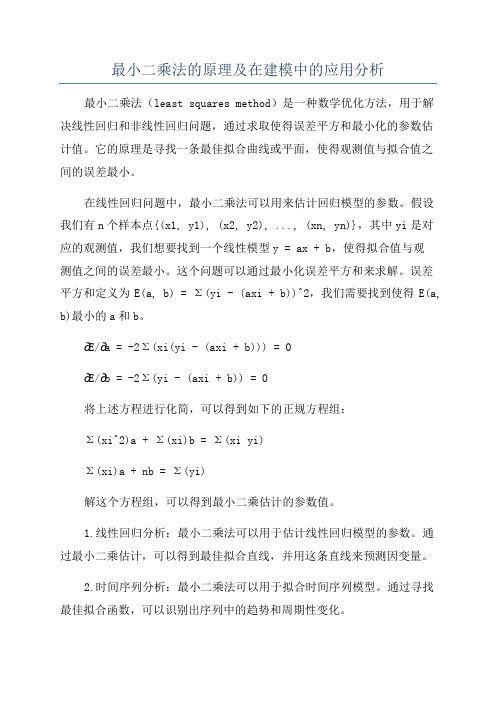
最小二乘法的原理及在建模中的应用分析最小二乘法(least squares method)是一种数学优化方法,用于解决线性回归和非线性回归问题,通过求取使得误差平方和最小化的参数估计值。
它的原理是寻找一条最佳拟合曲线或平面,使得观测值与拟合值之间的误差最小。
在线性回归问题中,最小二乘法可以用来估计回归模型的参数。
假设我们有n个样本点{(x1, y1), (x2, y2), ..., (xn, yn)},其中yi是对应的观测值,我们想要找到一个线性模型y = ax + b,使得拟合值与观测值之间的误差最小。
这个问题可以通过最小化误差平方和来求解。
误差平方和定义为E(a, b) = Σ(yi - (axi + b))^2,我们需要找到使得E(a, b)最小的a和b。
∂E/∂a = -2Σ(xi(yi - (axi + b))) = 0∂E/∂b = -2Σ(yi - (axi + b)) = 0将上述方程进行化简,可以得到如下的正规方程组:Σ(xi^2)a + Σ(xi)b = Σ(xi yi)Σ(xi)a + nb = Σ(yi)解这个方程组,可以得到最小二乘估计的参数值。
1.线性回归分析:最小二乘法可以用于估计线性回归模型的参数。
通过最小二乘估计,可以得到最佳拟合直线,并用这条直线来预测因变量。
2.时间序列分析:最小二乘法可以用于拟合时间序列模型。
通过寻找最佳拟合函数,可以识别出序列中的趋势和周期性变化。
3.统计数据处理:最小二乘法可以用于数据平滑和滤波处理。
通过拟合一个平滑曲线,可以去除数据中的噪声和不规则波动,从而提取出数据中的趋势信息。
4.多项式拟合:最小二乘法可以用于多项式拟合。
通过最小二乘估计,可以拟合出多项式函数,将其用于数据拟合和函数逼近。
5.曲线拟合:最小二乘法可以用于非线性曲线拟合。
通过选择合适的函数形式,并通过最小二乘估计求解参数,可以拟合出复杂的非线性曲线。
总之,最小二乘法是一种常用的参数估计方法,可以用于线性回归、非线性拟合、时间序列分析等多种建模问题。
最小二乘法的拟合

一、最小二乘法与最小一乘法1.什么时候用最小二乘法在研究两个变量之间的关系时,可以用回归分析的方法进行分析。
当确定了描述两个变量之间的回归模型后,就可以使用最小二乘法估计模型中的参数,进而建立经验方程.例如,在现实世界中,这样的情形大量存在着:两个变量X和Y(比如身高和体重)彼此有一些依赖关系,由X 可以部分地决定Y的值,但这种关系又是不确定的.人们常常借助统计学中的回归模型来寻找两个变量之间的关系,而模型的建立当然是依据观测数据.首先通过试验或调查获得x和Y的一组对应关系(x1,Y1),(x2,Y2),…,(x n,Y n),然后回答下列5个问题:1. 这两个变量是否有关系?(画出散点图,作直观判断)2. 这些关系是否可以近似用函数模型来描述?(利用散点图、已积累的函数曲线形状的知识和试验数据,选择适当的回归模型,如一元线性模型y=b0+b1x,二次函数模型y=b0+b1x+b2x2等)3. 建立回归模型.4. 对模型中的参数进行估计,最小二乘法是这些参数的一种常用估计方法.5. 讨论模型的拟合效果.在上述第3步中,设所建立的回归模型的一般形式是,其中Y称为响应变量,x称为解释变量或协变量;是一个由参数决定的回归函数;是一个不可观测的随机误差.为了通过试验数据来估计参数的值,可以采用许多统计方法,而最小二乘法是目前最常用、最基本的.由的估计值决定的方程称为经验回归方程或经验方程.教科书中涉及的回归模型是最简单的一元线性模型Y=b0+b1x+,此时模型的拟合效果可以通过Pearson相关系数来描述。
事实上,在线性回归模型中可以证明相关指数等于相关系数的平方.2.什么是最小二乘法思想简单地说,最小二乘的思想就是要使得观测点和估计点的距离的平方和达到最小.这里的“二乘”指的是用平方来度量观测点与估计点的远近(在古汉语中“平方”称为“二乘”),“最小”指的是参数的估计值要保证各个观测点与估计点的距离的平方和达到最小.例如,对于回归模型,若,…,为收集到的观测数据,则应该用来估计,这里是的估计值。
最小二乘法的曲线拟合
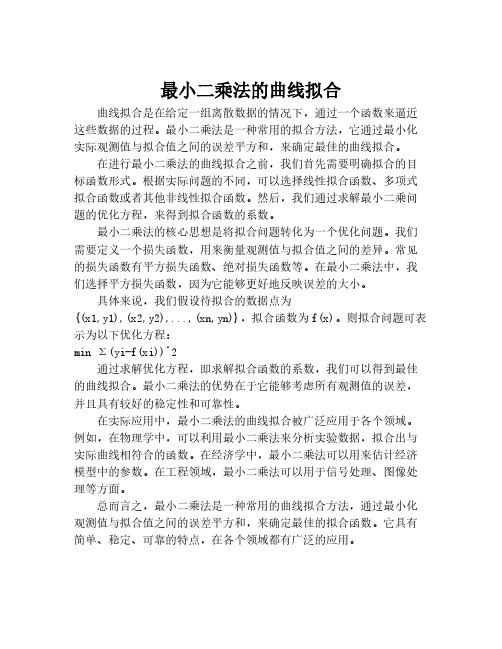
最小二乘法的曲线拟合曲线拟合是在给定一组离散数据的情况下,通过一个函数来逼近这些数据的过程。
最小二乘法是一种常用的拟合方法,它通过最小化实际观测值与拟合值之间的误差平方和,来确定最佳的曲线拟合。
在进行最小二乘法的曲线拟合之前,我们首先需要明确拟合的目标函数形式。
根据实际问题的不同,可以选择线性拟合函数、多项式拟合函数或者其他非线性拟合函数。
然后,我们通过求解最小二乘问题的优化方程,来得到拟合函数的系数。
最小二乘法的核心思想是将拟合问题转化为一个优化问题。
我们需要定义一个损失函数,用来衡量观测值与拟合值之间的差异。
常见的损失函数有平方损失函数、绝对损失函数等。
在最小二乘法中,我们选择平方损失函数,因为它能够更好地反映误差的大小。
具体来说,我们假设待拟合的数据点为{(x1,y1),(x2,y2),...,(xn,yn)},拟合函数为f(x)。
则拟合问题可表示为以下优化方程:min Σ(yi-f(xi))^2通过求解优化方程,即求解拟合函数的系数,我们可以得到最佳的曲线拟合。
最小二乘法的优势在于它能够考虑所有观测值的误差,并且具有较好的稳定性和可靠性。
在实际应用中,最小二乘法的曲线拟合被广泛应用于各个领域。
例如,在物理学中,可以利用最小二乘法来分析实验数据,拟合出与实际曲线相符合的函数。
在经济学中,最小二乘法可以用来估计经济模型中的参数。
在工程领域,最小二乘法可以用于信号处理、图像处理等方面。
总而言之,最小二乘法是一种常用的曲线拟合方法,通过最小化观测值与拟合值之间的误差平方和,来确定最佳的拟合函数。
它具有简单、稳定、可靠的特点,在各个领域都有广泛的应用。
三阶段最小二乘法步骤
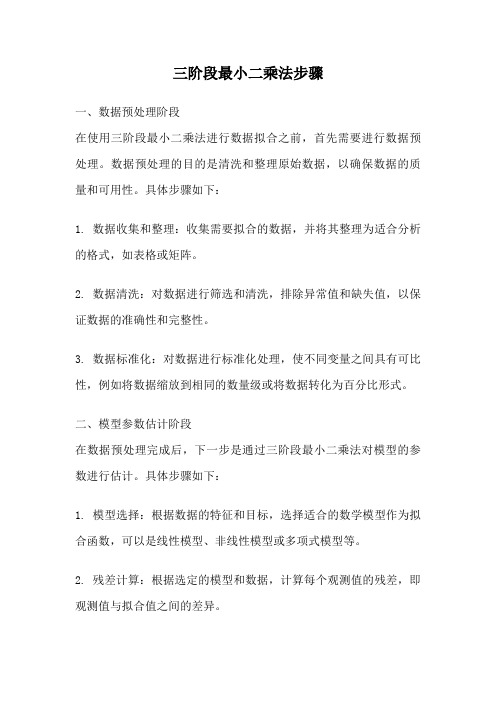
三阶段最小二乘法步骤一、数据预处理阶段在使用三阶段最小二乘法进行数据拟合之前,首先需要进行数据预处理。
数据预处理的目的是清洗和整理原始数据,以确保数据的质量和可用性。
具体步骤如下:1. 数据收集和整理:收集需要拟合的数据,并将其整理为适合分析的格式,如表格或矩阵。
2. 数据清洗:对数据进行筛选和清洗,排除异常值和缺失值,以保证数据的准确性和完整性。
3. 数据标准化:对数据进行标准化处理,使不同变量之间具有可比性,例如将数据缩放到相同的数量级或将数据转化为百分比形式。
二、模型参数估计阶段在数据预处理完成后,下一步是通过三阶段最小二乘法对模型的参数进行估计。
具体步骤如下:1. 模型选择:根据数据的特征和目标,选择适合的数学模型作为拟合函数,可以是线性模型、非线性模型或多项式模型等。
2. 残差计算:根据选定的模型和数据,计算每个观测值的残差,即观测值与拟合值之间的差异。
3. 参数估计:通过最小化残差平方和,确定模型的最佳参数估计值。
这可以通过求解一个最优化问题来实现,例如使用梯度下降法或牛顿法等优化算法。
三、模型评估与优化阶段在完成模型参数估计后,需要对拟合结果进行评估和优化,以确保模型的准确性和可靠性。
具体步骤如下:1. 拟合优度评估:通过计算拟合优度指标,如决定系数(R-squared)或均方根误差(RMSE),评估拟合模型的质量和拟合程度。
2. 模型优化:根据拟合优度评估结果,对模型进行优化调整。
可以尝试调整模型的参数或选择其他模型进行比较,以找到更好的拟合结果。
3. 结果解释和应用:根据最终的拟合结果,对模型进行解释和分析,提取有用的信息,并将拟合模型应用于实际问题中,进行预测或推断。
三阶段最小二乘法包括数据预处理阶段、模型参数估计阶段和模型评估与优化阶段。
通过这三个阶段的步骤,可以有效地进行数据拟合和模型建立,从而得到准确可靠的拟合结果。
在实际应用中,三阶段最小二乘法被广泛应用于统计分析、经济预测、信号处理等领域,为实现数据分析和预测提供了重要的工具和方法。
最小二乘法圆拟合

1.最小二乘法圆拟合原理理论最小二乘法(Least Square Method )是一种数学优化技术。
它通过最小化误差的平方和找到一组数据的最佳函数匹配。
利用最小二乘法可以简便地求得未知的数据,并使得这些求得的数据与实际数据之间误差的平方和为最小。
最小二乘圆拟合模型公式推导在二维平面坐标系中,圆方程一般可表示为:(A-A0)2+(y-y0)2=r2对于最小二乘法的圆拟合,其误差平方的优化目标函数为:式中:(兀切)心1,2,..丿为圆弧上特征点坐标M为参与拟合的特征点数。
在保持这优化目标函数特征的前提上,我们需要对其用一种稍微不同的改进方法来定义误差平方,且其避免了平方根,同时可得到一个最小化问题的直接解,定义如下:E= £[(兀一勺),+(>; -y0)2 -厂则(2)式可改写为:令,B = -2y0, A = -2x0C = x(; + y(;-r2即(3)式可表示为:H =2Sn =2s r ; + yf +:+y : + A2 + y ; +;=0 (=0J=o 1=0 ;=0 /=(> ;=0 丿 \/=()X =0(=0 1=01=0 (=0E =工(才 + V ; + A A ; + By t +C )/=()由最小二乘法原理,参数A, B, C 应使E 取得极小值。
根据极小 值的求法,A, 3和C 应满足求解方程组,先消去参数C,则式⑷“一⑹水工易得(=0•:-乞兀乞兀人+处〉必-亍兀文刃〃 +吃斤+,送席一乞(才(7)式(5)*n-(6)*^y.得1=0(8)M M =吃才-为册工"(9)\ /=() i=0 r=0 丿%=呱=卜£X 必-£者£订(10)\ H0 /=0 /=0 丿y : - dx/=0 /=0(13)r-0 f-0 H\=+ 辻灯-乞(X : + y ;应兀(12 ) rU) /-() ZU) /-0 H i=n X y :+n E vx- - Z (x ;+>?)E x将(7), (8)式写成矩阵形式根据式(14)和式(6)可得:人_円叽-側22^11^22 —^12^21—HB H -H 阀 u\2^ 21 一 M |22乞(才+貝+心+叭)c = _ ------------------------ n从而求得最佳拟合圆心坐标(心为),半径r 的拟合值:勺=_£,儿=_£,r = g J A +B? -4C2.仿真数据分析首先设置仿真圆心(xO, yO ),半径R0,在根据实际数据任意选取一 段圆弧,产生N 组随机数据。
最小二乘拟合 二次型quadprog优化方法

最小二乘拟合二次型quadprog优化方法最小二乘拟合二次型quadprog优化方法1、引言最小二乘拟合是一种常见的数据拟合方法,它通过最小化实际观测值与理论值之间的平方误差来寻找最佳拟合曲线或曲面。
而二次型quadprog优化方法则是一种用于求解二次型优化问题的常用数值方法。
本文将深入探讨最小二乘拟合和二次型quadprog优化方法,并分析它们在实际问题中的应用。
2、最小二乘拟合最小二乘拟合是一种用于拟合数据的常见方法,它通过最小化观测值与理论值之间的平方误差来寻找最佳的拟合参数。
最小二乘法的数学表达式为:\[ \sum_{i=1}^{n}(y_i - f(x_i))^2 \]其中,\(y_i\)为实际观测值,\(f(x_i)\)为理论值,\(n\)为观测数据的数量。
通过求取使得上式最小化的参数,即可得到拟合曲线或曲面的最佳参数。
最小二乘拟合广泛应用于各种领域,如统计分析、金融建模、工程优化等。
在金融建模中,最小二乘拟合常用于股价走势的预测;在工程优化中,最小二乘拟合可用于拟合工程实验数据,寻找最佳的工程参数。
3、二次型quadprog优化方法quadprog是一种用于求解二次型优化问题的数值方法,它的数学表达式为:\[ \min \frac{1}{2}x^T P x + q^T x \]\[ s.t. Gx \leq h, Ax = b \]其中,\(P\)为一个对称矩阵,\(q\)为一个向量,\(G\)和\(A\)分别为不等式约束和等式约束的系数矩阵,\(h\)和\(b\)分别为不等式约束和等式约束的右侧向量。
quadprog优化方法通过数值计算来求解上述二次型优化问题的最优解,它在实际问题中具有广泛的应用。
4、最小二乘拟合与二次型quadprog优化方法的联系最小二乘拟合问题本质上可以看作是一个二次型优化问题。
以线性拟合为例,其最小二乘问题的目标函数可以表示为:\[ \min \sum_{i=1}^{n}(y_i - (ax_i + b))^2 \]这个目标函数可以转化成一个二次型优化问题的形式,进而可以利用quadprog优化方法进行求解。
最小二乘拟合算法
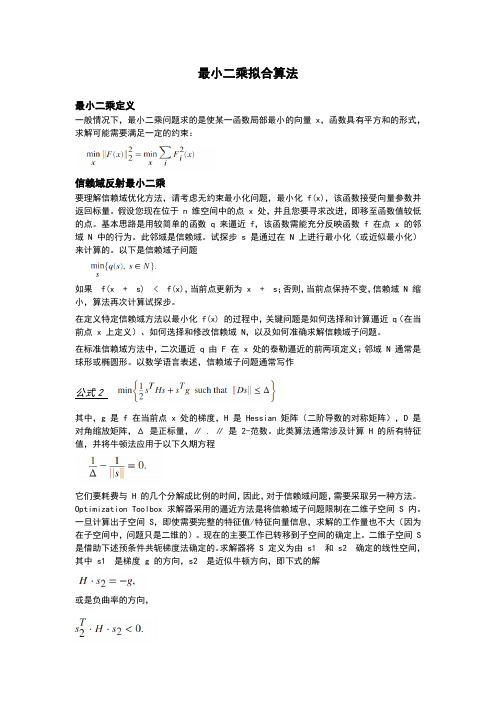
最小二乘拟合算法最小二乘定义一般情况下,最小二乘问题求的是使某一函数局部最小的向量 x,函数具有平方和的形式,求解可能需要满足一定的约束:信赖域反射最小二乘要理解信赖域优化方法,请考虑无约束最小化问题,最小化 f(x),该函数接受向量参数并返回标量。
假设您现在位于 n 维空间中的点 x 处,并且您要寻求改进,即移至函数值较低的点。
基本思路是用较简单的函数 q 来逼近 f,该函数需能充分反映函数 f 在点 x 的邻域 N 中的行为。
此邻域是信赖域。
试探步 s 是通过在 N 上进行最小化(或近似最小化)来计算的。
以下是信赖域子问题如果f(x + s) < f(x),当前点更新为 x + s;否则,当前点保持不变,信赖域 N 缩小,算法再次计算试探步。
在定义特定信赖域方法以最小化 f(x) 的过程中,关键问题是如何选择和计算逼近 q(在当前点 x 上定义)、如何选择和修改信赖域 N,以及如何准确求解信赖域子问题。
在标准信赖域方法中,二次逼近 q 由 F 在 x 处的泰勒逼近的前两项定义;邻域 N 通常是球形或椭圆形。
以数学语言表述,信赖域子问题通常写作公式2其中,g 是 f 在当前点 x 处的梯度,H 是 Hessian 矩阵(二阶导数的对称矩阵),D 是对角缩放矩阵,Δ是正标量,∥ . ∥是 2-范数。
此类算法通常涉及计算 H 的所有特征值,并将牛顿法应用于以下久期方程它们要耗费与 H 的几个分解成比例的时间,因此,对于信赖域问题,需要采取另一种方法。
Optimization Toolbox 求解器采用的逼近方法是将信赖域子问题限制在二维子空间 S 内。
一旦计算出子空间 S,即使需要完整的特征值/特征向量信息,求解的工作量也不大(因为在子空间中,问题只是二维的)。
现在的主要工作已转移到子空间的确定上。
二维子空间 S 是借助下述预条件共轭梯度法确定的。
求解器将 S 定义为由 s1 和 s2 确定的线性空间,其中 s1 是梯度 g 的方向,s2 是近似牛顿方向,即下式的解或是负曲率的方向,以此种方式选择 S 背后的理念是强制全局收敛(通过最陡下降方向或负曲率方向)并实现快速局部收敛(通过牛顿步,如果它存在)。
热电偶最优化分段最小二乘拟合线性化处理方法

热电偶最优化分段最小二乘拟合线性化处理方法Ξ赵明富1,2 廖强2 钟连超1 罗渝微1(1重庆工学院电子信息工程与自动化学院,重庆400050;2重庆大学动力学院工程热物理研究所,重庆400044)摘 要 针对虚拟测温仪器中的热电偶线性化问题,提出了一种适合多种热电偶和热电阻的在线拟合方法,该方法是一种基于最小二乘法低阶分段曲线拟合来实现热电偶的软件线性化处理方法,通过软件编程实现了在不等测温区间内分段运用最小二乘法获得不同的拟合函数,并给出一种热电偶的拟合结果。
运用该方法可提高测温的灵活性和准确性。
关键词 热电偶 线性化 最小二乘法 拟合 热电偶由于具有结构简单、热容最小、材料的互换性好、信号能够远距离传送和多点测量,便于检测和控制等优点,因此把热电偶与计算机配合,用热电偶作为感温元件的微机化测温仪在工业生产和科学研究中得到了广泛的应用。
但由于它的热电势—温度函数关系的非线性,在应用中必须进行冷端补偿和线性补偿处理。
通常这种线性处理的方法有两大类:硬件化线性处理,如采用硬件线性化电路板来补偿;软件线性处理,即通过具体的算法,编制程序来修正。
过去常用硬件电路板来线性化处理,但存在成本较高、误差较大,电路搭配僵化,不灵活等缺点。
然而,随着计算机的广泛应用,特别是虚拟测温仪器出现的今天,软件线性化以其方法多样,拟合精度高,速度快,偏差小而被广泛应用[1~5]。
本文针对虚拟测温仪器中的热电偶线性化问题,提出了一种适合多种热电偶和热电阻的在线拟合方法,该方法是一种基于最小二乘法低阶分段曲线拟合来实现热电偶的软件线性化处理方法。
其目的为了提高虚拟测量仪器的通用性、适应性、实时性和测量精度。
一、线性化方法中的拟合原理通常在IEC584-1标准中给出的温度t和热电偶的热电势E之间的解析表达式为:E=f(t)(1)其中f(t)为高阶多项式函数或高阶多项式函数与指数函数的复合函数。
如镍铬———镍硅热电偶在温度为0~1372℃时解析表达式为:E=∑8i=0a i t i+125exp[-12(t-12765)2](2)如果已知某一时刻的温度值,就可通过计算得出热电偶在该时刻的热电势,反之亦然。
最小二乘法在数据拟合中的应用

最小二乘法在数据拟合中的应用数据拟合是科学研究、工程设计等领域中常见的问题,它是指根据已知的数据,通过一定的方法,建立一个能够描述数据特征的数学模型。
通常情况下,这些数据点之间存在着一些误差,因此拟合出的模型不可能完全精确地描述实际情况。
在这种情况下,最小二乘法就成了处理数据拟合问题的重要工具之一。
最小二乘法是一种数学优化方法,它的主要思想是寻求一种数学函数,使得该函数与一组给定的数据点之间的误差平方和最小。
这个方法的应用范围非常广泛,不仅可以用于数据拟合问题,还可以用于解决图像处理、信号处理、回归分析等许多实际问题。
需要注意的是,最小二乘法只适用于某些类型的函数拟合问题。
具体来说,当我们希望拟合的函数可以表示为线性组合形式时,最小二乘法就成为了一种有效的求解方法。
在最小二乘法中,我们通常会选择一种函数形式,然后调整函数中的参数,使得该函数与所有数据点之间的距离最小。
为了达到这个目标,我们通常会计算每个数据点到拟合函数的垂直距离,即残差,然后将所有的残差平方相加,得到误差平方和。
最终我们需要调整函数中的参数,使得误差平方和最小。
例如,我们可以尝试使用一个一阶多项式函数拟合一组数据点:$y = ax + b$对于每一个数据点 $i$,我们可以计算该数据点到拟合的直线上的垂直距离为:$e_i = y_i - (ax_i + b)$我们可以将所有的残差平方相加,得到误差平方和:$S(a,b) = \sum\limits_{i}^n e_i^2 = \sum\limits_{i}^n (y_i - ax_i - b)^2$现在的问题是如何求解 $a$ 和 $b$,使得误差平方和$S(a,b)$ 最小。
这时候,最小二乘法就派上用场了。
我们可以使用偏导数的方法,求得误差平方和对 $a$ 和 $b$ 的导数,然后令它们等于零,解出最小二乘估计值。
具体来说,我们可以得到以下两个方程:$\dfrac{\partial S}{\partial a} = -2\sum\limits_{i}^n (y_i - ax_i - b)x_i = 0$$\dfrac{\partial S}{\partial b} = -2\sum\limits_{i}^n (y_i - ax_i - b) = 0$解这两个方程得到:$a = \dfrac{\sum\limits_{i}^n x_i y_i -\dfrac{1}{n}(\sum\limits_{i}^n x_i)(\sum\limits_{i}^ny_i)}{\sum\limits_{i}^n x_i^2 - \dfrac{1}{n}(\sum\limits_{i}^nx_i)^2}$$b = \bar{y} - a\bar{x}$其中,$\bar{x}$ 和 $\bar{y}$ 分别是 $x$ 和 $y$ 的平均值。
基于最小二乘法的数据拟合与分析

基于最小二乘法的数据拟合与分析数据拟合与分析,是现代科技中非常重要的一个工具,能够在大量数据中发现规律并有效利用。
其中,最小二乘法是实现数据拟合的一个常用数学方法。
下面,我们将详细探讨基于最小二乘法的数据拟合与分析。
一、最小二乘法的基本原理最小二乘法是一种数学优化技术,通常用于拟合线性回归模型。
其基本思想是通过寻找一条曲线,使样本的残差平方和最小化,达到最佳拟合效果。
在最小二乘法中,我们假设有一个数据集合D,其中包含n个样本点{(x1,y1),(x2,y2),...,(xn,yn)},而模型的形式可以表示为y=f(x,w),其中w为模型参数,例如:y = w0 + w1 x表示一条直线。
然后,我们希望通过最小二乘法来确定最佳的模型参数。
在这个模型中,我们定义残差ei为:ei = yi - f(xi, w),表示第i个样本点与拟合曲线之间的垂直距离。
然后,我们可以通过最小化残差平方和来确定最佳拟合效果,即最小化目标函数:S = Σ ei^2 = Σ (yi - f(xi, w))^2二、数据拟合的步骤基于最小二乘法进行数据拟合,通常需要通过以下步骤来完成:1. 选择合适的模型函数:这是拟合的起点。
我们需要根据数据的特性和拟合目标选择一个合适的模型函数,例如线性函数、多项式函数、指数函数等。
2. 定义拟合函数:有了一个合适的模型函数,我们需要用数学公式来表示它,并生成一个用于计算的函数。
3. 确定模型参数:我们需要确定模型参数w。
对于线性模型,有两个参数w0和w1;对于多项式模型,则会有更多的参数。
4. 计算残差:我们需要计算每个数据点与拟合曲线的残差ei,以反映样本数据的误差情况。
5. 最小化目标函数:通过最小化目标函数,我们可以得到最佳的模型参数值,以实现最佳拟合效果。
6. 评估拟合效果:最后,我们需要评估拟合效果如何,并决定是否需要进一步优化模型。
在这个过程中,最关键的是选择合适的模型函数。
如果选择的模型不太适合数据的特性,那么拟合的效果可能会很差,甚至无法拟合。
平面向量的最小二乘法和最优拟合
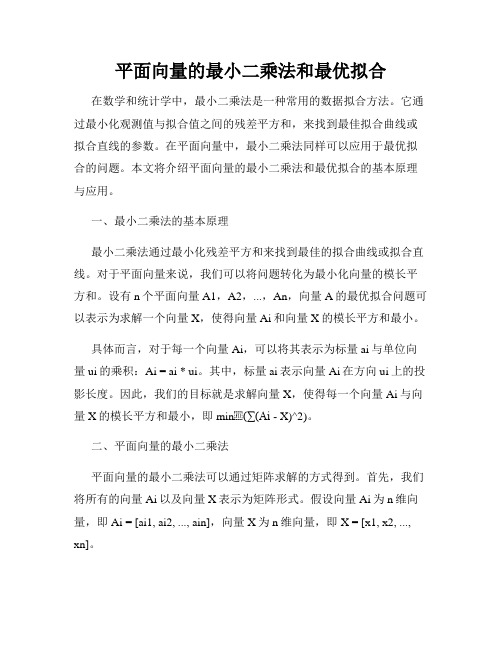
平面向量的最小二乘法和最优拟合在数学和统计学中,最小二乘法是一种常用的数据拟合方法。
它通过最小化观测值与拟合值之间的残差平方和,来找到最佳拟合曲线或拟合直线的参数。
在平面向量中,最小二乘法同样可以应用于最优拟合的问题。
本文将介绍平面向量的最小二乘法和最优拟合的基本原理与应用。
一、最小二乘法的基本原理最小二乘法通过最小化残差平方和来找到最佳的拟合曲线或拟合直线。
对于平面向量来说,我们可以将问题转化为最小化向量的模长平方和。
设有n个平面向量A1,A2,...,An,向量A的最优拟合问题可以表示为求解一个向量X,使得向量Ai和向量X的模长平方和最小。
具体而言,对于每一个向量Ai,可以将其表示为标量ai与单位向量ui的乘积:Ai = ai * ui。
其中,标量ai表示向量Ai在方向ui上的投影长度。
因此,我们的目标就是求解向量X,使得每一个向量Ai与向量X的模长平方和最小,即min(∑(Ai - X)^2)。
二、平面向量的最小二乘法平面向量的最小二乘法可以通过矩阵求解的方式得到。
首先,我们将所有的向量Ai以及向量X表示为矩阵形式。
假设向量Ai为n维向量,即Ai = [ai1, ai2, ..., ain],向量X为n维向量,即X = [x1, x2, ..., xn]。
将所有的向量Ai表示为矩阵形式,得到矩阵A = [A1, A2, ..., An]。
将向量X表示为矩阵形式,得到矩阵X = [X]。
那么,最小二乘问题就可以表示为求解矩阵X,使得(A - X)的模长平方和最小,即min∥ A - X∥^2。
为了求解上述最小二乘问题,我们需要计算矩阵A的转置矩阵AT和矩阵A与AT的乘积ATA,以及矩阵A与向量A的乘积AAT。
然后,通过计算线性方程组ATA * X = AAT的解X,即可得到最优的拟合向量X。
三、最优拟合的应用最优拟合在平面向量的应用中非常广泛。
例如,在二维平面上,我们可以使用最小二乘法来拟合一条最优直线。
最优化条件求解最小二乘方程

最优化条件求解最小二乘方程
最小二乘法是一种常用的优化方法,用于求解最优拟合问题。
它被广泛应用于各个领域,包括统计学、经济学、工程学等等。
最小二乘法的核心思想是通过最小化误差平方和来寻找最佳拟合曲线或平面。
在使用最小二乘法求解问题时,首先需要确定一个数学模型,然后通过收集实际观测数据,将模型与观测数据进行比较。
接下来,使用最小二乘法的优化条件,对模型进行调整,使得模型与观测数据之间的误差最小化。
最小二乘法的优化条件可以通过求解导数为零的方程来得到。
这个方程通常是一个线性方程组,可以通过求解线性方程组来获得最小二乘法的最优解。
在求解线性方程组的过程中,可以使用各种数值方法,如高斯消元法、LU分解法等等。
最小二乘法的优势在于它是一种数学上严格的方法,可以得到精确的结果。
然而,最小二乘法也有一些限制,比如对于非线性模型,最小二乘法可能无法得到全局最优解,而只能得到局部最优解。
除了最小二乘法,还有一些其他的优化方法,如遗传算法、粒子群算法等等。
这些方法有着不同的优势和适用范围,可以根据具体问题的特点来选择合适的方法。
在实际应用中,最小二乘法可以用于拟合曲线、回归分析、参数估
计等等。
通过最小二乘法,可以得到模型的参数估计值,并评估参数估计的精度。
这对于科学研究和工程设计都具有重要意义。
最小二乘法是一种常用的优化方法,它通过最小化误差平方和来寻找最佳拟合曲线或平面。
通过求解导数为零的方程,可以得到最小二乘法的优化条件。
最小二乘法在各个领域都有广泛的应用,是一种重要的数学工具。
多个点最小二乘法拟合圆心

多个点最小二乘法拟合圆心
最小二乘法可以用于多个点拟合圆心。
该方法的基本步骤如下:
1. 定义变量:设圆心为$(x_0,y_0)$,半径为$r$,数据点为$\{(x_1,y_1),(x_2,y_2),\ldots,(x_n,y_n)\}$。
2. 构建模型:对于每个数据点$(x_i,y_i)$,计算它到圆心的距离$d_i$,并计算所有距离的平方和$S$。
$S=\sum(d_i^2)$。
3. 求解最优解:对$S$关于$x_0,y_0$和$r$求极小值,即求解函数$f(x_0,y_0,r)=\sum(d_i^2)$的极小值。
通常,这是一个非线性优化问题,需要使用特定的优化算法来解决。
常用的优化算法包括梯度下降法、牛顿法等。
4. 估计误差:计算模型预测值与实际值之间的误差,以评估模型的拟合效果。
误差越小,说明模型的拟合效果越好。
5. 检验拟合结果:通过一些统计检验(如卡方检验、$F$检验等)来检验所得到的拟合圆是否显著。
通过最小二乘法拟合圆心,可以获得较为准确的圆心坐标和半径,从而更好地理解数据的分布规律。
在实际应用中,可以根据具体需求选择合适的优化算法和统计检验方法,以获得更精确的结果。
最小二乘法和最优化算法初步
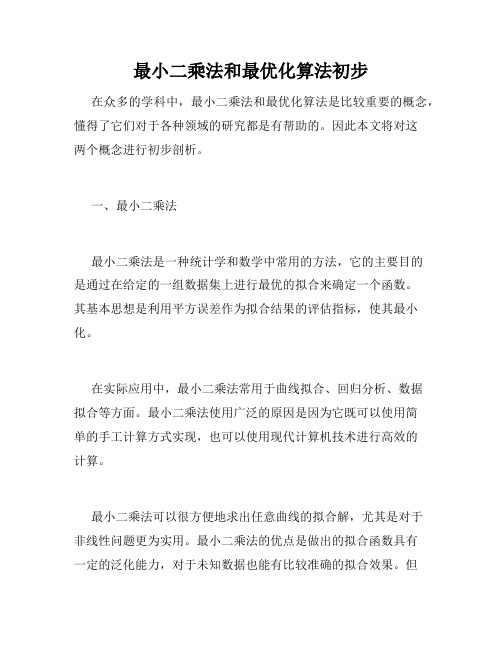
最小二乘法和最优化算法初步在众多的学科中,最小二乘法和最优化算法是比较重要的概念,懂得了它们对于各种领域的研究都是有帮助的。
因此本文将对这两个概念进行初步剖析。
一、最小二乘法最小二乘法是一种统计学和数学中常用的方法,它的主要目的是通过在给定的一组数据集上进行最优的拟合来确定一个函数。
其基本思想是利用平方误差作为拟合结果的评估指标,使其最小化。
在实际应用中,最小二乘法常用于曲线拟合、回归分析、数据拟合等方面。
最小二乘法使用广泛的原因是因为它既可以使用简单的手工计算方式实现,也可以使用现代计算机技术进行高效的计算。
最小二乘法可以很方便地求出任意曲线的拟合解,尤其是对于非线性问题更为实用。
最小二乘法的优点是做出的拟合函数具有一定的泛化能力,对于未知数据也能有比较准确的拟合效果。
但其局限性是只有一个自变量的拟合问题比较简单,多个自变量的拟合问题要更复杂,并需要使用更为复杂的计算方法。
二、最优化算法最优化算法是数学和计算机科学中的一个研究方向,其目标是通过使用优化方法,寻找函数局部或者全局最小值。
最优化算法的主要应用领域包括工程设计、物理学、经济学、金融学等等。
常见的最优化算法有牛顿-拉夫森法、梯度下降法、共轭梯度法、随机梯度下降法等。
最优化算法通过对目标函数进行分析和求导,以及对目标函数的具体要求,从而对其进行调整和改进,使得求解出结果更为准确、更为快速。
最优化算法的优点在于它具有较高的求解效率和准确度,能够很好地解决一些复杂的问题。
但其缺点是它需要大量的计算资源和时间,对于特定问题的求解可能会比较困难。
三、最小二乘法与最优化算法的联系最小二乘法和最优化算法都是数学和计算机科学中重要的研究方向。
它们之间有广泛的联系和交叉研究,具体表现如下:1. 最小二乘法可以看作是求解目标函数的过程,而最优化算法可以对目标函数进行进一步的求解,并使其更加接近最优解。
2. 在求解非线性问题时,最小二乘法通常需要引入最优化算法进行优化,以使其更好地适应数据。
最小二乘法算法

最小二乘法算法最小二乘法算法最小二乘法算法是一种常用的拟合曲线方法,被广泛应用于各个领域。
它的主要思想是通过最小化误差平方和来找出数据点与构建的曲线之间的最佳匹配。
在本文中,我们将从数学原理、应用场景和优缺点等方面对最小二乘法算法进行介绍。
数学原理上,最小二乘法算法是通过最小化数据点到拟合曲线的垂直距离(又称残差)的平方和来进行拟合。
假设我们有一组数据点{(x1,y1), (x2, y2), ... (xn, yn)},我们想要找到一个函数f(x)来拟合这些数据。
最小二乘法算法通过求解下面的优化问题来找到最佳的拟合曲线:argmin Σ(yi - f(xi))^2其中,f(xi)表示在给定的x值处函数的取值,yi是对应的实际观测值。
通过求解这个优化问题,我们可以得到最佳的函数f(x),使得误差平方和达到最小。
最小二乘法算法的应用场景非常广泛。
在统计学中,它被用于回归分析,以拟合数据并估计变量之间的关系。
在金融学中,最小二乘法常用于计算资产收益率的参数估计和风险度量。
在信号处理中,最小二乘法可以用于信号去噪和参数估计。
此外,最小二乘法还在计算机视觉、机器学习和优化问题等领域得到广泛应用。
最小二乘法算法有很多优点。
首先,它具备数学原理明确、计算简单高效的特点。
其次,最小二乘法算法能够充分考虑数据点的权重,从而对观测误差进行合理的处理。
此外,最小二乘法算法还具备良好的数学性质,例如解的存在性和唯一性。
这些优点使得最小二乘法算法成为了一个被广泛接受和使用的方法。
当然,最小二乘法算法也存在一些缺点。
首先,它对异常值和离群点非常敏感。
如果数据中存在不符合模型假设的点,最小二乘法算法的拟合结果可能会受到很大影响。
此外,最小二乘法算法也存在过拟合的问题,即过度拟合训练数据而失去了对未知数据的泛化能力。
因此,在应用最小二乘法算法时,我们需要对数据进行预处理和模型选择来减少这些问题的影响。
综上所述,最小二乘法算法是一种重要的数学工具,用于数据拟合和参数估计。
最小二乘法曲线拟合原理
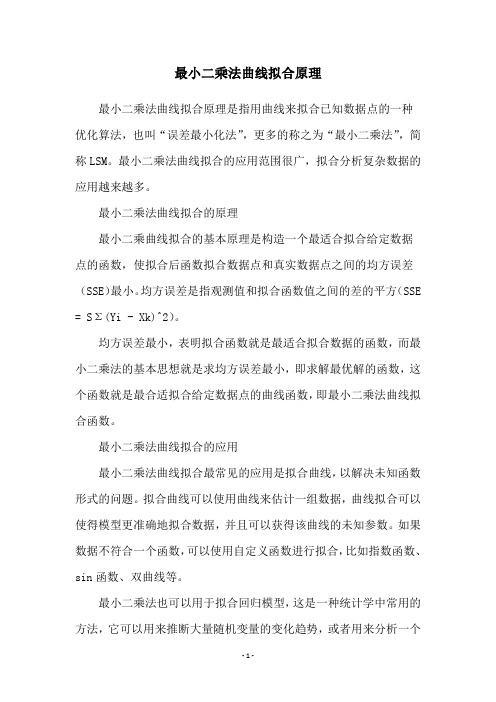
最小二乘法曲线拟合原理最小二乘法曲线拟合原理是指用曲线来拟合已知数据点的一种优化算法,也叫“误差最小化法”,更多的称之为“最小二乘法”,简称LSM。
最小二乘法曲线拟合的应用范围很广,拟合分析复杂数据的应用越来越多。
最小二乘法曲线拟合的原理最小二乘曲线拟合的基本原理是构造一个最适合拟合给定数据点的函数,使拟合后函数拟合数据点和真实数据点之间的均方误差(SSE)最小。
均方误差是指观测值和拟合函数值之间的差的平方(SSE = SΣ(Yi - Xk)^2)。
均方误差最小,表明拟合函数就是最适合拟合数据的函数,而最小二乘法的基本思想就是求均方误差最小,即求解最优解的函数,这个函数就是最合适拟合给定数据点的曲线函数,即最小二乘法曲线拟合函数。
最小二乘法曲线拟合的应用最小二乘法曲线拟合最常见的应用是拟合曲线,以解决未知函数形式的问题。
拟合曲线可以使用曲线来估计一组数据,曲线拟合可以使得模型更准确地拟合数据,并且可以获得该曲线的未知参数。
如果数据不符合一个函数,可以使用自定义函数进行拟合,比如指数函数、sin函数、双曲线等。
最小二乘法也可以用于拟合回归模型,这是一种统计学中常用的方法,它可以用来推断大量随机变量的变化趋势,或者用来分析一个可能受其他变量影响的变量之间的关系。
最小二乘法也可以用于数值估计,比如最小二乘法用于数值拟合,用于数值拟合可以求出未知函数的参数,用于回归分析中,可以估计因变量受自变量影响的参数。
最小二乘法曲线拟合的缺点最小二乘法曲线拟合的最大缺点是其依赖性强:由于拟合的曲线函数有固定形式,因此无法拟合数据点的异常值,也无法拟合数据不具有规律性的情况;另外,最小二乘法曲线拟合也可能因过拟合导致拟合出的函数复杂度较高,从而影响精度。
总结最小二乘法曲线拟合原理指用曲线来拟合已知数据点的一种优化算法,它的基本原理是构造一个最适合拟合给定数据点的函数,使拟合后函数拟合数据点和真实数据点之间的均方误差最小。
- 1、下载文档前请自行甄别文档内容的完整性,平台不提供额外的编辑、内容补充、找答案等附加服务。
- 2、"仅部分预览"的文档,不可在线预览部分如存在完整性等问题,可反馈申请退款(可完整预览的文档不适用该条件!)。
- 3、如文档侵犯您的权益,请联系客服反馈,我们会尽快为您处理(人工客服工作时间:9:00-18:30)。
Least Squares Fit
Abstract:
The techniques of least squares optimization have their origins in problems of curve fitting, and of finding the best possible solution for a system of linear equations with infinitely many solutions. Curve fitting problems begin with data points (t 1, S 1), . . . , (tn' sn) and a given class of functions (for example, linear functions, polynomial functions, exponential functions), and seek to identify the function S = f(t) that "best fits" the data points. On the other hand, such problems as finding the minimum distance in geometric contexts or minimum variance in statistical contexts can often be solved by finding the solution of minimum norm for an underdetermined linear system of equations.
Keyword:Least Squares、Fit、Equations
Text:Suppose that in a certain experiment or study, we record a series of observed values (t 1 , Sl), (t 2 , S2), ..., (tn, Sn) of two variables s, t that we have reason to believe are related by a function s = f(t) of a certain type. For example, we might know that sand t are related by a polynomial function
of degree < k, where k is prescribed in advance, but we do not know the specific values of the coefficients xo, Xl' ..., X k of p(t). We are interested in choosing the values of these coefficients so that the deviations
between the observed value Si at t i and the value p(tJ of p(t) at t i , are all as small as possible.
One reasonable approach to this problem is to minimize the function
over all (X o , Xl' . . . , x k ) in R k + 1. Al tho ugh the use of the "square deviation" (Si - p(tJ)2 in place of the raw deviation ISi - p(tJI can be justified purely in terms of the convenience afforded by the resulting differentiability of qJ, this choice has some theoretical advantages that will soon become evident. Recall that the customary approach to the minimization of the function qJ(x o , Xl' . .., x k ) is to set the gradient of qJ equal to zero and solve the resulting system for xo, Xl' ..., X k (cf. Exercise 18 of Chapter 1). This produces the minimizers of qJ because qJ is a convex function of xo, Xl' ..., X k (Why?) and so any critical point of qJ is a global minimizer. Our approach to this mini- mization problem is similar but somewhat more refined. We first observe that the function qJ(x o , Xl' .. . , X k ) can be expressed con- veniently in terms of the norm on Rk+l. Specifically, if we set
Then
Therefore, the gradient and Hessian of qJ are given by
Now here is the pertinent observation: Since the numbers t l' t 2' . . ., t n are distinct values of the independent variable t, the columns of the matrix A are linearly independent. This means that if Ax = 0 then x = 0 since Ax is simply a linear combination of the column vectors of A. But then, because
we see that H qJ(x) is positive definite. It follows from (2.3.7) that qJ(x) is strictly convex on Rk+l and so qJ(x) has unique global minimizer at the point x* for which VqJ(x*) = o. Since VqJ(x) = - 2A T b + 2A T Ax, we see that the minimize x* of qJ is characterized by the so-called normal equation
The matrix AT A is invertible because it is positive definite, so x* is also given by
If x* = (X6, xi, ..., xt), then the polynomial
is called the best least squares (kth degree polynomial) fit for the given
data. In the special case when k = 1, the least squares procedure fits a line
to the given data points (t 1, S1), (t 2 , S2), ..., (tn, sn). This line is called the linear regression line for the given data.。
